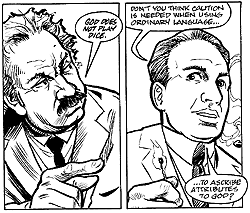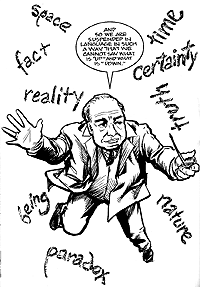
|
Bohr's life (1885 - 1962) is roughly divided into two halves: the years of his seminal contributions to atomic science, and his later role as scientific statesman during and after WW II. Ottaviani and Purvis take care to explain the concepts behind Bohr's multiple scientific breakthroughs, making the book a kind of illustrated primer on atomic physics. It was Bohr, for example, who proposed a model of the atom as a kind of mini solar system, with electrons orbiting around a nucleus. But this had its limits, both experimentally and "philosophically." So he moved to introduce Quantum Mechanics as a system of atomic theories best known for its postulation that the act of observing something affects the results of that observation. An electron, for example, which exhibits behaviors associated with the opposing concepts of particles or waves, will become one or the other depending on which you look for. Finally, his suggested model of the atom's nucleus as having surface tension (like a water droplet) provided a key development towards releasing nuclear energy.
Leland Purvis's black and white art, always readable and clear, moves ably back and forth from conventional comix storytelling to more metaphorical sequences explaining the science. Still, "Suspended in Language" does better at dramatizing Bohr's life than at illuminating his theories. If, like me, you couldn't pass a current high school physics exam, you will likely find much of the high math and various connections between ideas a bit heady and confusing. Fortunately, the pacing of the book is such that even if you don't totally get, say, the importance of Planck's Constant or even what it is, Ottaviani's enthusiasm still makes you excited about it.
 Einstein vs. Bohr: Atomic Showdown
Einstein vs. Bohr: Atomic Showdown |
After the drama of discovery in the first half, "Suspended in Language" turns into a something of a cloak-and-dagger thriller. When the Nazis occupied Denmark, Bohr remained under virtual house arrest for both his Jewish heritage and his anti-Nazi worldview. He survived this way until 1943 when, days before being taken away, he escaped to England in the bomber hold of an allied aircraft. Eventually he made his way to the top-secret Manhattan Project where his theories were being tested on the making of a nuclear bomb. He soon became a security concern, however, since his philosophical and globalist nature drove him to encourage open sharing of nuclear information with the Russians. Though he failed to head off the arms race before it began, he continued his open world efforts into the post-war era until his death.
Unlike more academically minded biographers, Ottaviani and Purvis give us as much personality as they do science. Along with the bigger events of Bohr's life the book includes the kind of trivial but telling moments that add nuance to his personality. In one sequence he pouts because, although he convinces his reluctant wife to buy the baby carriage he wants, he really wanted her to believe in the decision, rather than just acquiesce. Purvis, for his part, does a fine job of bringing Bohr and his contemporaries alive with animated caricatures. Together, Purvis and Ottaviani's portrait of Bohr reveals a deeply principled, humble man who could be as playful (using spinning tops and ping pong balls for inspiration) as he could be serious minded.
 Niels Bohr is suspended in language
Niels Bohr is suspended in language |
But the move that really puts "Suspended in Language" beyond rote, educational biography is the very literary manner in which Ottaviani has centered the book on a theme of the power of language. The title becomes the key. At first it seems a small joke in reference to Bohr's logorrheaic writings, whose impenetrability became legendary. But gradually Ottaviani builds on Bohr's relationship with language. Near the end, the authors take a bold leap beyond the "fourth wall," using the comic language itself as the embodiment of Bohr's ideas. In a breathtaking moment, Bohr points to the gutter between panels and notes that it is two things simultaneously: a space and unit of time. The medium itself embodies his idea of a thing being one thing when observed one way and its opposite when observed another way. This remarkable sequence ends with Bohr floating in a borderless void of words — literally suspended in language.
Both educational and entertaining, Jim Ottaviani and Leland Purvis' "Suspended in Language" stands out as a comic that smartly uses its medium as part of its message. Generating as many philosophical questions as physics answers, it embodies the spirit of Bohr's life and ideas: It changes depending on how you look at it.
